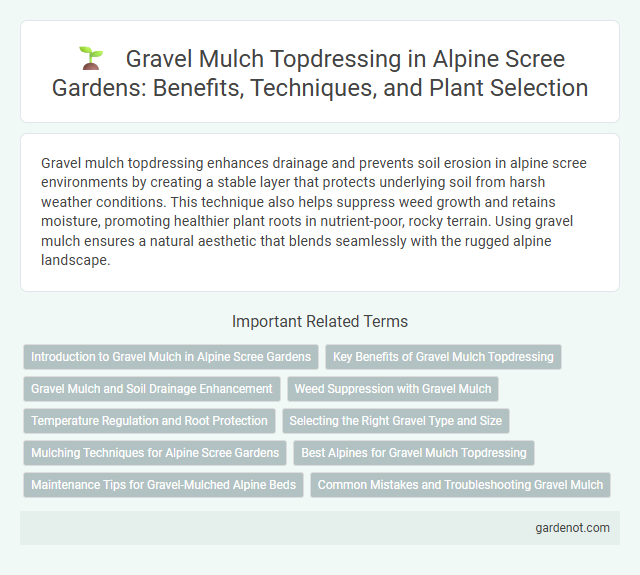Gravel mulch topdressing enhances drainage and prevents soil erosion in alpine scree environments by creating a stable layer that protects underlying soil from harsh weather conditions. This technique also helps suppress weed growth and retains moisture, promoting healthier plant roots in nutrient-poor, rocky terrain. Using gravel mulch ensures a natural aesthetic that blends seamlessly with the rugged alpine landscape.
Introduction to Gravel Mulch in Alpine Scree Gardens
Gravel mulch in alpine scree gardens serves as an effective topdressing, enhancing soil moisture retention while promoting drainage essential for rock-adapted plants. This method mimics natural scree slopes, providing stability and reducing erosion around shallow-rooted alpine species. Incorporating varied gravel sizes optimizes microclimates, supporting biodiversity and plant health in high-altitude garden environments.
Key Benefits of Gravel Mulch Topdressing
Gravel mulch topdressing enhances alpine scree gardens by improving soil drainage and reducing erosion, critical for maintaining root stability in rocky environments. This method aids in moisture retention while preventing weed growth, promoting healthier plant establishment and growth. The durable gravel layer also protects delicate alpine plants from temperature fluctuations and harsh weather conditions, ensuring long-term garden sustainability.
Gravel Mulch and Soil Drainage Enhancement
Gravel mulch topdressing in alpine scree environments significantly improves soil drainage by creating a permeable layer that prevents waterlogging and promotes aeration around plant roots. The coarse texture of gravel mulch facilitates rapid water infiltration, reducing surface runoff and soil erosion while maintaining optimal moisture levels for alpine vegetation. Enhanced soil drainage through gravel mulch supports healthier root systems, crucial for sustaining plant resilience in harsh, rocky terrains.
Weed Suppression with Gravel Mulch
Gravel mulch topdressing effectively suppresses weeds by creating a dense, inhospitable barrier that limits sunlight and reduces soil disturbance, preventing weed seed germination in alpine scree environments. The gravel's coarse texture enhances drainage while minimizing soil erosion and moisture retention, which further inhibits weed growth by depriving seeds of necessary conditions. Optimal gravel mulch thickness ranges from 2 to 5 centimeters, balancing weed control with the preservation of native alpine plant roots and microhabitats.
Temperature Regulation and Root Protection
Gravel mulch topdressing in alpine scree environments effectively regulates soil temperature by reducing thermal fluctuations, maintaining cooler root zones during hot daytime conditions and warmer temperatures at night. This natural insulation protects delicate root systems from extreme temperature stress, promoting healthier plant growth and resilience. The gravel layer also minimizes soil moisture evaporation, supporting stable hydration essential for alpine vegetation survival.
Selecting the Right Gravel Type and Size
Selecting the right gravel type and size for alpine scree gravel mulch topdressing is crucial for promoting proper drainage and preventing soil erosion. Opt for angular gravel with a particle size ranging from 10 to 20 millimeters to ensure stability while allowing adequate water infiltration. Using uniform, crushed stone enhances root aeration and supports the delicate alpine vegetation adapted to rocky substrates.
Mulching Techniques for Alpine Scree Gardens
Gravel mulch topdressing is an effective mulching technique for alpine scree gardens, promoting soil moisture retention and temperature regulation critical for high-altitude plant survival. Using coarse, angular gravel mimics natural scree environments, enhancing drainage while preventing soil erosion and reducing weed growth. Properly applied mulch layers of 2-5 cm create an optimal microclimate that supports alpine species such as Saxifraga and Draba, ensuring healthy root development and minimal fungal issues.
Best Alpines for Gravel Mulch Topdressing
Best alpines for gravel mulch topdressing include Sedum, Saxifraga, and Aubrieta species, known for their drought tolerance and low maintenance. These plants thrive in well-drained gravel mulch, promoting healthy root systems while preventing soil erosion. Their compact growth habit and vibrant blooms enhance the aesthetic appeal and functional benefits of gravel mulch gardens.
Maintenance Tips for Gravel-Mulched Alpine Beds
Gravel mulch topdressing in alpine scree beds reduces soil erosion and improves moisture retention, requiring periodic inspection to prevent compaction and weed growth. Regularly raking the gravel helps maintain aeration and drainage, while spot-treating invasive weeds minimizes competition with alpine plants. Replenishing gravel every 2-3 years ensures continued protection and aesthetic appeal in these specialized garden environments.
Common Mistakes and Troubleshooting Gravel Mulch
Gravel mulch topdressing on alpine scree often suffers from common mistakes such as applying gravel too thickly, which can impede water infiltration and root oxygenation, or using inappropriate gravel sizes that disrupt plant stability and soil moisture retention. Troubleshooting these issues involves selecting appropriately sized, angular gravel to enhance drainage and reduce compaction while maintaining a mulch layer thickness of 2-3 centimeters to balance protection and breathability. Regular monitoring for gravel displacement and root exposure helps prevent erosion and supports optimal alpine plant growth in scree environments.
Gravel mulch topdressing Infographic

 gardenot.com
gardenot.com